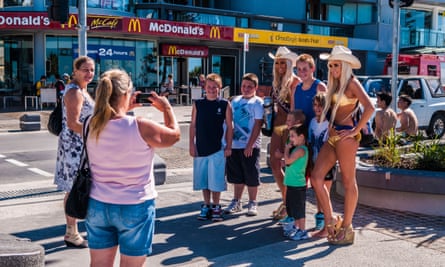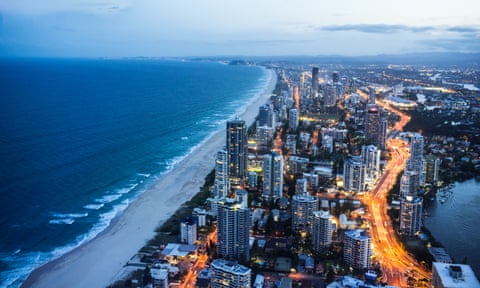Pristine beaches stretching for 70km, enviable weather, world heritage-listed Gondwana rainforests, and enough big city infrastructure to keep punters interested – Australia’s Gold Coast is a pleasure centre. But for many it has a pervasive dark side: a city once branded as a sunny place for shady people.
One of Australia’s most revered writers once told me he comes here to have his breakdowns. On a visit in 1997, Prince Charles was reported to have said its gaudy skyscrapers contributed to the “uglification” of one of the world’s top holiday spots. In 1984, the prominent Sydney architect Neville Gruzman suggested the city should be bulldozed into the surf.
Today, the Gold Coast seems to be attempting that reinvention itself. It is Australia’s fastest growing city and larger than three of its capital cities (Canberra, Hobart and Darwin), with the 2018 Commonwealth Games doubtless accelerating a maturation already under way.
Every month or so there’s a new hip place to be seen, an old high rise disappears and a shiny new one soars. Every week some new claim is made for the ultimate in gastronomic happiness.
Do these ventures live up to the hype? Sometimes. But it hardly matters. The Gold Coast is a city built on hype, on rise and fall. As a longtime resident, I’ve experienced several waves of self-proclaimed urban renaissance and learned that, while the spin exists largely to generate the sale of sky homes, each growth phase possesses a grain of truth.

The Gold Coast wants to grow up. But is that possible when the rest of the country’s estimations of it are so rigid?
Unlike many major Australian cities, the Gold Coast does not retain much evidence of a colonial urban sensibility, in part because of rampant redevelopment and erasure, but largely because it never really got started.
The urban vision was always more closely linked to a 20th-century American aesthetic. The influence of the strip cities of Miami, Los Angeles and particularly Las Vegas are in evidence as well as, more recently, nods to the 21st-century architectural ambition of Dubai and Shanghai. While each of these cities have marked differences they all share a postwar history of urban expansion and proliferation.
All have grown at phenomenal rates, new frontier cities that owe less to major port affiliations or centrifugal notions of planning than they do to strip formations, late capitalism and experimental development. The big-ticket architecture says so.
The $1bn luxury Jewel project currently under development epitomises this push for opulent new millennium design. An example of continuing high-end investment in architectural innovation, the development is a six-star three-tower structure modelled on shards of smoky quartz crystals found on a mountain in the region. The interpretation is refreshingly abstract compared with the ubiquitous “palm tree, primary colour” resort styling the Gold Coast has leaned so much on in the past.

Across many sectors, the city is shrugging off the declarative localism it has played to in exchange for a more sophisticated spin on where it sits in the world. It will be interesting to note how the international spotlight will burn. In 2016, international tourism figures peaked at one million. Tourists from Asia make up the majority of those, as they have for decades. People from Singapore get the Gold Coast, as do people people from Hong Kong and Dubai – they are all cities that share a new frontier urban aesthetic.
The real opposition to the Gold Coast’s ambition is national. Australians often experience the city in hyperactive mode, arriving to soak up the sun and get away with what they’re less likely to at home; raging down streets like no one lives here, hiring mopeds and tuk tuks blasting Justin Bieber or AC/DC, high on party drugs or table-sized martinis.
Q&AWhat is Australian cities week?
Show
Guardian Cities is dedicating a week to exploring the opportunities and challenges of Australia's rapidly growing cities. The nation of nearly 25 million has one of the fastest-rising populations of all OECD countries, overwhelmingly focused on its biggest cities: Sydney and Melbourne. But with car dependence, urban sprawl and unaffordable housing threatening their famed "liveability", are they ready for the challenge? Canberra, Adelaide, Perth, Hobart, Darwin and Brisbane face similar issues, while nationwide, poor indigenous consultation is a growing urban issue. Australian Cities Week, a collaboration with Guardian Australia, seeks to reveal and celebrate the culture, architecture, wildlife and character that bolster these cities' reputations as unique and desirable places to live.
They may have visited in a pack of mates at the annual Schoolies festival – a Spring Break equivalent that erupted in the 1970s and still attracts tens of thousands of school leavers. Or they may have vibrant memories of flying through the hyperreal universes of the Dreamworld, Movieworld and Seaworld theme parks as kids.
It’s these off-kilter experiences – the combination of bright lights, sunburnt skin and cringey recollections – twinned with the consistent media overplay that continue to define national opinions of a city locals affectionately refer to as “the Goldie”.

It is not unusual for major cities to have underworlds: corrupt power centres and schlocky, sometimes violent nightclub strips. It’s just that the depiction of such things erupting on Australia’s Gold Coast makes great trash TV. Stock footage proliferates of schoolies vomiting in bins, bikies brawling in restaurants, meter maids in gold bikinis and bare-knuckle violence – but these things exist as a fraction of a much larger whole.
The burgeoning arts scene is emblematic of the city’s evolution. Twenty years ago, arts visibility, policy and recognition barely existed, and certainly not at levels that could match commercial imperatives. Today, the Gold Coast can hold its own. Under the directives of the Culture Strategy 2023, the city council has invested $7m in the development of an arts and cultural programme for Festival 2018, linked to the Commonwealth Games, while a $365m cultural precinct funded by all levels of government will be launched in stages.
Yet the attitude of the rest of Australia towards the city, even though it is now one of the top five tourist destinations nationally, seems to be: “We want you to stay in your box.” Evidence of the Gold Coast’s continuing appeal as a preferred place to holiday and live goes largely unacknowledged.
In part, this paradox is related to class. Australia prides itself on being an egalitarian society, but it can be highly parochial and territorial. The rivalry between Sydney and Melbourne is legendary; neither would ever consider the Gold Coast as worthy of debate.

The city’s location in Queensland doesn’t help. From 1968 to 1987, the state was under the corrupt rule of the disgraced premier Joh Bjelke-Petersen, known as the “hillbilly dictator”, who fostered the creation of a police state and opposed homosexuality, abortion, demonstrations against anti-apartheid and even the 40-hour work week. Perceptions of Queenslanders have been affected ever since.
This state of play is changing, but a whiff of snobbery still exists. Southerners expect us to smash them in football games and pull together in natural disasters, displaying the kind of spirit that helped us survive “Joh” in the first place. But the notion that the locals are unintelligent – “They all talk slower up there because of the heat” – endures. When the 1% holiday in Australia, they tend to go elsewhere.
This is no different from the idea that Parisians are all rude or New Yorkers unfriendly. The Gold Coast is more dynamic than its enduring mythologies suggest. It does not so much resemble an overgrown Porpoise Spit, the mythical town made famous by the film Muriel’s Wedding: an acrylic land of hoop earrings, dumb surfers and undone housewives burning down backyards.
Cities have moods and boroughs, and things only locals know. They are at their best when they surprise; when you sink in to the city and relate to it on its own terms. The Gold Coast has been allowed to be trashy, glitzy and even obscene, as long as it doesn’t gatecrash the VIP party – one smoky quartz slipper already dangerously close to the rope. In any case, this won’t be the city’s last renaissance.
In collaboration with Guardian Australia, Guardian Cities is devoting a week to Australian cities. Share your thoughts with Guardian Cities on Twitter, Facebookand Instagram using the hashtag #AusWk
